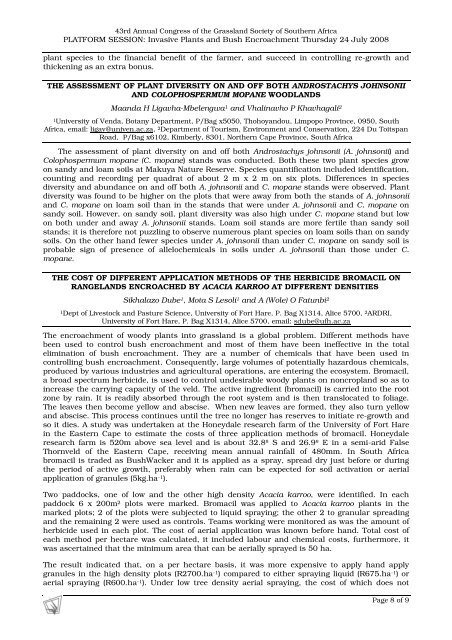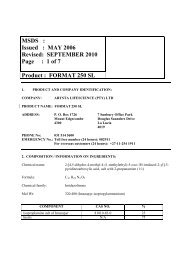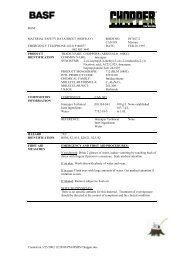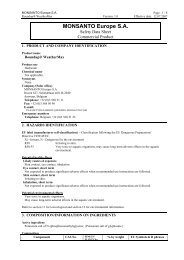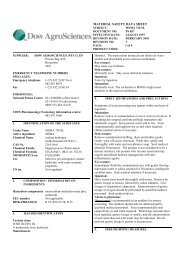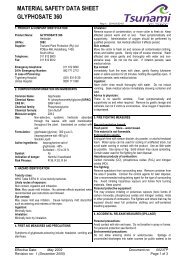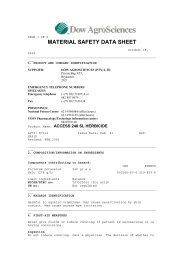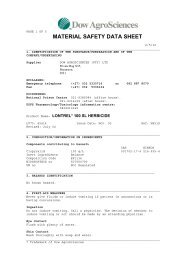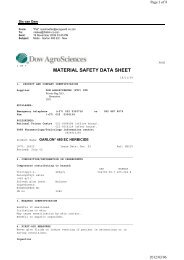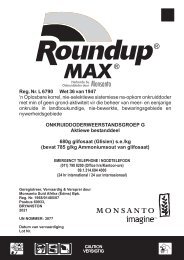Invasive Plants and Bush Encroachment
Invasive Plants and Bush Encroachment
Invasive Plants and Bush Encroachment
Create successful ePaper yourself
Turn your PDF publications into a flip-book with our unique Google optimized e-Paper software.
43rd Annual Congress of the Grassl<strong>and</strong> Society of Southern Africa<br />
PLATFORM SESSION: <strong>Invasive</strong> <strong>Plants</strong> <strong>and</strong> <strong>Bush</strong> <strong>Encroachment</strong> Thursday 24 July 2008<br />
plant species to the financial benefit of the farmer, <strong>and</strong> succeed in controlling re-growth <strong>and</strong><br />
thickening as an extra bonus.<br />
THE ASSESSMENT OF PLANT DIVERSITY ON AND OFF BOTH ANDROSTACHYS JOHNSONII<br />
AND COLOPHOSPERMUM MOPANE WOODLANDS<br />
Ma<strong>and</strong>a H Ligavha-Mbelengwa 1 <strong>and</strong> Vhalinavho P Khavhagali 2<br />
1University of Venda, Botany Department, P/Bag x5050, Thohoy<strong>and</strong>ou, Limpopo Province, 0950, South<br />
Africa, email: ligav@univen.ac.za, 2 Department of Tourism, Environment <strong>and</strong> Conservation, 224 Du Toitspan<br />
Road, P/Bag x6102, Kimberly, 8301, Northern Cape Province, South Africa<br />
The assessment of plant diversity on <strong>and</strong> off both Androstachys johnsonii (A. johnsonii) <strong>and</strong><br />
Colophospermum mopane (C. mopane) st<strong>and</strong>s was conducted. Both these two plant species grow<br />
on s<strong>and</strong>y <strong>and</strong> loam soils at Makuya Nature Reserve. Species quantification included identification,<br />
counting <strong>and</strong> recording per quadrat of about 2 m x 2 m on six plots. Differences in species<br />
diversity <strong>and</strong> abundance on <strong>and</strong> off both A. johnsonii <strong>and</strong> C. mopane st<strong>and</strong>s were observed. Plant<br />
diversity was found to be higher on the plots that were away from both the st<strong>and</strong>s of A. johnsonii<br />
<strong>and</strong> C. mopane on loam soil than in the st<strong>and</strong>s that were under A. johnsonii <strong>and</strong> C. mopane on<br />
s<strong>and</strong>y soil. However, on s<strong>and</strong>y soil, plant diversity was also high under C. mopane st<strong>and</strong> but low<br />
on both under <strong>and</strong> away A. johnsonii st<strong>and</strong>s. Loam soil st<strong>and</strong>s are more fertile than s<strong>and</strong>y soil<br />
st<strong>and</strong>s; it is therefore not puzzling to observe numerous plant species on loam soils than on s<strong>and</strong>y<br />
soils. On the other h<strong>and</strong> fewer species under A. johnsonii than under C. mopane on s<strong>and</strong>y soil is<br />
probable sign of presence of allelochemicals in soils under A. johnsonii than those under C.<br />
mopane.<br />
THE COST OF DIFFERENT APPLICATION METHODS OF THE HERBICIDE BROMACIL ON<br />
RANGELANDS ENCROACHED BY ACACIA KARROO AT DIFFERENT DENSITIES<br />
Sikhalazo Dube 1 , Mota S Lesoli 1 <strong>and</strong> A (Wole) O Fatunbi 2<br />
1Dept of Livestock <strong>and</strong> Pasture Science, University of Fort Hare, P. Bag X1314, Alice 5700, 2 ARDRI,<br />
University of Fort Hare, P. Bag X1314, Alice 5700, email: sdube@ufh.ac.za<br />
The encroachment of woody plants into grassl<strong>and</strong> is a global problem. Different methods have<br />
been used to control bush encroachment <strong>and</strong> most of them have been ineffective in the total<br />
elimination of bush encroachment. They are a number of chemicals that have been used in<br />
controlling bush encroachment. Consequently, large volumes of potentially hazardous chemicals,<br />
produced by various industries <strong>and</strong> agricultural operations, are entering the ecosystem. Bromacil,<br />
a broad spectrum herbicide, is used to control undesirable woody plants on noncropl<strong>and</strong> so as to<br />
increase the carrying capacity of the veld. The active ingredient (bromacil) is carried into the root<br />
zone by rain. It is readily absorbed through the root system <strong>and</strong> is then translocated to foliage.<br />
The leaves then become yellow <strong>and</strong> abscise. When new leaves are formed, they also turn yellow<br />
<strong>and</strong> abscise. This process continues until the tree no longer has reserves to initiate re-growth <strong>and</strong><br />
so it dies. A study was undertaken at the Honeydale research farm of the University of Fort Hare<br />
in the Eastern Cape to estimate the costs of three application methods of bromacil. Honeydale<br />
research farm is 520m above sea level <strong>and</strong> is about 32.8º S <strong>and</strong> 26.9º E in a semi-arid False<br />
Thornveld of the Eastern Cape, receiving mean annual rainfall of 480mm. In South Africa<br />
bromacil is traded as <strong>Bush</strong>Wacker <strong>and</strong> it is applied as a spray, spread dry just before or during<br />
the period of active growth, preferably when rain can be expected for soil activation or aerial<br />
application of granules (5kg.ha -1 ).<br />
Two paddocks, one of low <strong>and</strong> the other high density Acacia karroo, were identified. In each<br />
paddock 6 x 200m 2 plots were marked. Bromacil was applied to Acacia karroo plants in the<br />
marked plots; 2 of the plots were subjected to liquid spraying; the other 2 to granular spreading<br />
<strong>and</strong> the remaining 2 were used as controls. Teams working were monitored as was the amount of<br />
herbicide used in each plot. The cost of aerial application was known before h<strong>and</strong>. Total cost of<br />
each method per hectare was calculated, it included labour <strong>and</strong> chemical costs, furthermore, it<br />
was ascertained that the minimum area that can be aerially sprayed is 50 ha.<br />
The result indicated that, on a per hectare basis, it was more expensive to apply h<strong>and</strong> apply<br />
granules in the high density plots (R2700.ha -1 ) compared to either spraying liquid (R675.ha -1 ) or<br />
aerial spraying (R600.ha -1 ). Under low tree density aerial spraying, the cost of which does not<br />
Page 8 of 9


